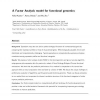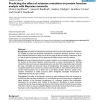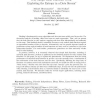824 search results - page 16 / 165 » The Structure Function and Distinguishable Models of Data |
BMCBI
2006
13 years 7 months ago
2006
Background: Expression array data are used to predict biological functions of uncharacterized genes by comparing their expression profiles to those of characterized genes. While b...
TCS
2010
13 years 5 months ago
2010
We present a new approach for an average-case analysis of algorithms and data structures that supports a non-uniform distribution of the inputs and is based on the maximum likelih...
BMCBI
2006
13 years 7 months ago
2006
Background: A number of methods that use both protein structural and evolutionary information are available to predict the functional consequences of missense mutations. However, ...
CVPR
2010
IEEE
14 years 3 months ago
2010
IEEE
Psychologists have proposed that many human-object interaction activities form unique classes of scenes. Recognizing these scenes is important for many social functions. To enable...
SODA
2008
ACM
13 years 9 months ago
2008
ACM
Hashing is fundamental to many algorithms and data structures widely used in practice. For theoretical analysis of hashing, there have been two main approaches. First, one can ass...



